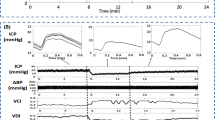Abstract
Background
External ventricular drains (EVD) are widely used to manage intracranial pressure (ICP) and hydrocephalus for aneurysmal subarachnoid hemorrhage (aSAH) patients. After days of use, a decision is made to remove the EVD or replace it with a shunt, involving EVD weaning and CT imaging to observe ventricular size and clinical status. This practice may lead to prolonged hospital stay, extra radiation exposure, and neurological insult due to ICP elevation. This study aims to apply a validated morphological clustering analysis of ICP pulse (MOCAIP) algorithm to detect signatures from the pulse waveform to differentiate an intact CSF circulatory system from an abnormal one during EVD weaning.
Methods
We performed a retrospective study with 50 aSAH patients with reported weaning trial admitted to our institution between 03/2013 and 08/2014. By reviewing clinical notes and pre/post-brain imaging results, 32 patients were determined as having passed the weaning trial and 18 patients as having failed the trial. MOCAIP algorithm was applied to ICP signals to form a series of artifact-free dominant pulses. Finally, pulses with similar mean ICP were identified, and amplitude, Euclidean, and geodesic inter-pulse distances were calculated in a 4-h moving window.
Results
While the traditional measure of mean ICP failed to differentiate the two groups of patients, the proposed amplitude and morphological inter-pulse measures presented significant differences (p ≤ 0.004). Moreover, receiver operating characteristic (ROC) analyses showed their usability to predict the outcome of the EVD weaning trial (AUC 0.85, p < 0.001).
Conclusions
Patients with an impaired CSF system showed a larger mean and variability of inter-pulse distances, indicating frequent changes on the morphology of pulses. This technique may provide a method to rapidly determine if patients will need placement of a shunt or can simply have the EVD removed.









Similar content being viewed by others
References
D’Souza S. Aneurysmal subarachnoid hemorrhage. J Neurosurg Anesthesiol. 2015;27:222–40.
Connolly ES, Rabinstein AA, Carhuapoma JR, Derdeyn CP, Dion J, Higashida RT, et al. Guidelines for the management of aneurysmal subarachnoid hemorrhage: a guideline for healthcare professionals from the American heart association/American stroke association. Stroke. 2012;43:1711–37.
Weir B, Grace M, Hansen J, Rothberg C. Time course of vasospasm in man. J Neurosurg. 1978;48:173–8.
Slazinkski T, Anderson T, Cattell E, Eigsti J, Heimsoth S, Holleman J, et al. Care of the patient undergoing intracranial pressure monitoring/external ventricular drainage or lumbar drainage. 2011. http://www.aann.org/uploads/AANN11_ICPEVDnew.pdf.
Hu X, Xu P, Scalzo F, Vespa P, Bergsneider M. Morphological clustering and analysis of continuous intracranial pressure. IEEE Trans Biomed Eng. 2009;56:696–705.
Hu X, Gonzalez N, Bergsneider M. Steady-state indicators of the intracranial pressure dynamic system using geodesic distance of the ICP pulse waveform. Physiol. Meas. 2012;33:2017–31. http://www.ncbi.nlm.nih.gov/pubmed/23151442.
Hamilton R, Baldwin K, Fuller J, Vespa P, Hu X, Bergsneider M. Intracranial pressure pulse waveform correlates with aqueductal cerebrospinal fluid stroke volume. J Appl Physiol. 2012;113:1560–6. http://www.pubmedcentral.nih.gov/articlerender.fcgi?artid=3524656&tool=pmcentrez&rendertype=abstract.
Eide PK. A new method for processing of continuous intracranial pressure signals. Med Eng Phys. 2006;28:579–87.
Benjamini Y, Hochberg Y. Controlling the false discovery rate: a practical and powerful approach to multiple testing. J R Stat Soc. 1995;57:289–300.
Klopfenstein JD, Kim LJ, Feiz-Erfan I, Hott JS, Goslar P, Zabramski JM, et al. Comparison of rapid and gradual weaning from external ventricular drainage in patients with aneurysmal subarachnoid hemorrhage: a prospective randomized trial. J Neurosurg. 2004;100:225–9. http://www.ncbi.nlm.nih.gov/pubmed/15086228.
Kang DH, Park J, Park SH, Kim YS, Hwang SK, Hamm IS. Early ventriculoperitoneal shunt placement after severe aneurysmal subarachnoid hemorrhage: role of intraventricular hemorrhage and shunt function. Neurosurgery. 2010;66:904–8.
Chan S, Josephson SA, Rosow L, Smith WS. A quality assurance initiative targeting radiation exposure to neuroscience patients in the intensive care unit. Neurohospitalist. 2015;5:9–14.
Acknowledgments
The authors wish to thank Annabel Teng and Andrea Villaroman for their support at the different stages of the study. This work was partially supported by the UCSF Middle Career Scientist Award, UCSF Institute for Computational Health Sciences, and R01NS076738.
Author information
Authors and Affiliations
Corresponding author
Rights and permissions
About this article
Cite this article
Arroyo-Palacios, J., Rudz, M., Fidler, R. et al. Characterization of Shape Differences Among ICP Pulses Predicts Outcome of External Ventricular Drainage Weaning Trial. Neurocrit Care 25, 424–433 (2016). https://doi.org/10.1007/s12028-016-0268-4
Published:
Issue Date:
DOI: https://doi.org/10.1007/s12028-016-0268-4




